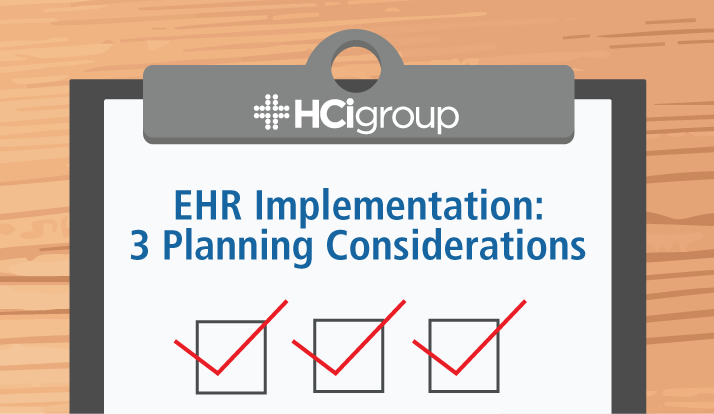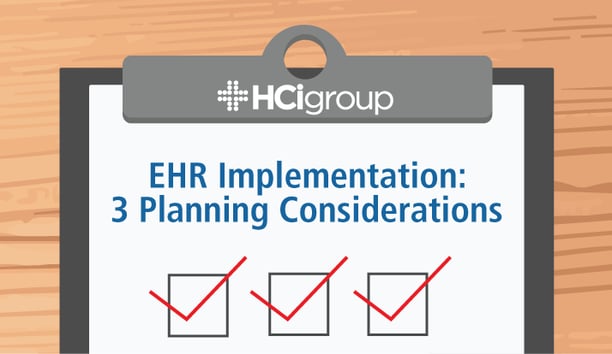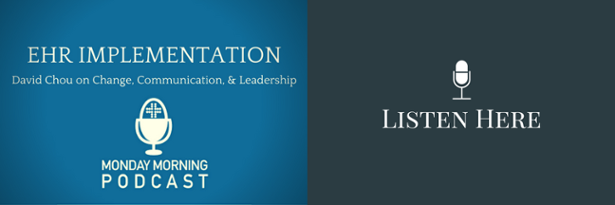EHR Implementation: 3 Planning Considerations


Healthcare facilities that are considering replacing their current health record with an EHR know that it can be a complex process before reaching the goals they set out at the beginning of their project. Implementing an EHR can lead to an increase in revenue, ease of use for physicians, and an overall increase in patient care. It is important, however, that healthcare organizations be prepared for the challenges that go hand-in-hand with an EHR implementation project.
Making sure that your organization has done extensive planning can go a long way in alleviating some of the issues that can arise during an EHR implementation. In today’s blog post, HCI's Cindy Klukas goes over 3 areas that organizations must consider when planning for an EHR implementation project.
1) Pace and Type of EHR Implementation
One of the biggest decisions organizations must make has to deal with how they intend to implement their new EHR. Some organizations choose to go “big bang,” where they bring up the entire system all at once while others choose to implement in phases. Working as an Epic analyst for the last 12 years, I have found advantages and disadvantages to both methods.
One major advantage to going with the “big bang” method is that build teams can generally identify the major road blocks such as hardware issues, equipment compatibility, third-party software integration, special workflow issues, etc., and can deal with them during the initial phases of design, build, and validation. In organizations that have chosen to implement in phases, I have noticed more difficulties with equipment compatibility, hardware issues, billing, and the handling of special workflow issues created by other modules going up first – which leads to a need to compensate for lack of functionality that the specialty modules offer.
Before making a final decision on a plan for implementation speed, organizations should identify all potential roadblocks and determine which method would best meet the needs of the organization. Without doing a comprehensive assessment, organizations could be setting themselves up for an unsuccessful implementation.
2) Technical Issues
Technical issues are another area of focus that office-based providers need to consider while planning for an EHR implementation. Most EHRs will provide specific metrics listing the appropriate hardware requirements needed in order to go-live. Oftentimes, space for adding additional workstations, network jacks, server space, and equipment requirements recommended are not always spatially or financially feasible, and customers find themselves with budgetary issues before the software has even been implemented.
During my last EHR implementation, the project leadership did not budget for equipment and connectivity. They assumed that since device integration was already being utilized in the operating rooms, there would be no additional need for equipment or network jacks. What they failed to consider is that the existing anesthesia machines, physiological monitors attached to those machines, cardiac output, and BIS machines were not being integrated. On a walkthrough done by the build team, we identified a lack of network jacks in many of the operating rooms, and there was an identified need to purchase middleware in order to gain maximum benefit from device integration once the EHR was live.
Since the individual hospital IT teams were not aware that additional network jacks may need to be added and additional equipment purchased, they did not budget for these expenses. Therefore, the project budget suffered a major blow and had to come up with the additional money for each site. In order to avoid these types of additional costs and possible delays due to technical issues, organizations and office-based providers should solicit input from the IT and build teams, as well as other organizations that have implemented a similar EHR, when creating a project budget.
3) Staffing Your EHR Implementation
Staffing is another major consideration for an EHR implementation. When an organization or office decides to implement, some EHRs will have recommendations on the number of resources needed for a successful implementation. The build team is then assembled, and the key stakeholders are engaged based on these recommendations. In my experience, EHRs tend to underestimate the number of resources required for implementation.
When it comes to assembling the core build team, healthcare facilities should consider the skill level of the analysts. If the team will be comprised of less experienced individuals, the customer should consider supplementing the build team with additional FTEs – even if the EHR recommends less. Oftentimes, customers find themselves unable to meet the project milestones and struggle to hire on consultants, or to pull analysts from other teams to try to assist with the completion of the build.
Additional phases in implementation where resources are often underestimated is during shadow charting and go-live. EHRs will recommend that end users participate in shadow charting a few months prior to go-live in order to familiarize themselves with the system, help the build team identify potential break/fix issues, and to help the project leadership with data on documentation usage and efficacy. Adding additional resources for this stage of implementation is not typically recommended, and customers tend to experience push back with shadow charting because there is not enough elbow-to-elbow support offered. This is also true for go-live – there are generally not enough resources available to provide the level of end user support and command center support that end users expect.Healthcare facilities should consider the computer literacy of the end users in the organization or practice, and the number of staff available to support a go-live or shadow charting. If there are any deficits in staffing, customers should consider budgeting for outside resources, as this will lead to a more successful and less stressful implementation.
With careful planning, healthcare organizations and office-based providers can avoid many of the pitfalls that can arise during an EHR implementation. For more information on what you can do to facilitate ease in your EHR implementation process, make sure to contact us.



